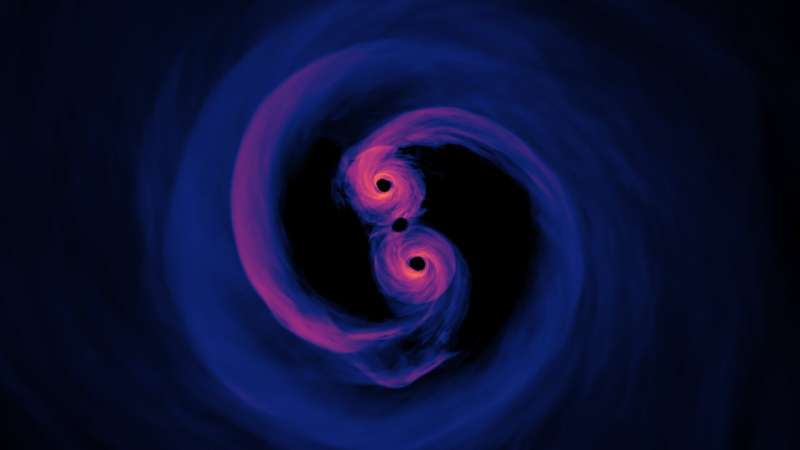
Simulation of light emitted by a binary supermassive black hole system where the surrounding gas is optically thin (transparent). Viewed from 0 degrees inclination, or directly above the disk plane. The emitted light represents all wavelengths. Credit: NASA Goddard Space Flight Center/Scott Noble; simulation data, from Ascoli et al. 2018
Researchers have discovered a link between some of the largest and smallest objects in the cosmos: supermassive black holes and dark matter particles.
Their new calculations reveal that pairs of supermassive black holes (SMBHs) can merge into a single, larger black hole due to the previously overlooked behavior of dark matter particles, offering a solution to astronomy’s long-standing “final parsec problem.”
The research is described in “Self-interacting dark matter solves the final parsec problem of supermassive black hole mergers,” published this month in the journal Physical Exam Letters.
In 2023, astrophysicists announced the detection of a “hum” of gravitational waves permeating the universe. They hypothesized that this background signal emanated from millions of pairs of merging SMBHs, each billions of times more massive than our Sun.
However, theoretical simulations have shown that when pairs of these gigantic celestial objects spiral toward each other, their approach stops when they are about a parsec apart (a distance of about three light-years), preventing a merger.
Not only did this “final parsec problem” conflict with the theory that SMBH mergers were the source of the gravitational wave background, it also conflicted with the theory that SMBHs develop from the merger of less massive black holes.
“We show that including the previously neglected effect of dark matter can help supermassive black holes overcome this last parsec of separation and merge,” says Gonzalo Alonso-Álvarez, co-author of the study and a postdoctoral researcher in the Department of Physics at the University of Toronto and the Department of Physics and Trottier Space Institute at McGill University. “Our calculations explain how this can happen, contrary to what was previously thought.”
The paper’s co-authors are Professor James Cline of McGill University and the Department of Theoretical Physics at CERN in Switzerland and Caitlyn Dewar, a master’s student in physics at McGill.
SMBHs are thought to be found at the centers of most galaxies, and when two galaxies collide, the SMBHs fall into orbit around each other. As they orbit each other, the gravitational pull of nearby stars pulls on them and slows them down. As a result, the SMBHs spiral inward toward a merger.
Previous merger models have shown that as SMBHs approach within about a parsec, they begin to interact with the dark matter cloud or halo in which they are embedded. They have indicated that the gravity of the spiraling SMBHs knocks the dark matter particles out of the system, and the resulting scarcity of dark matter means that energy is not extracted from the pair and their mutual orbits no longer shrink.
While these models ignored the impact of dark matter on the SMBH’s orbits, Alonso-Álvarez and colleagues’ new model reveals that dark matter particles interact with each other in such a way that they are not scattered. The density of the dark matter halo remains high enough that interactions between the particles and the SMBHs continue to degrade the SMBH’s orbits, setting the stage for a merger.
“The possibility that dark matter particles interact with each other is an assumption we have made, an additional ingredient that not all dark matter models contain,” Alonso-Álvarez explains. “Our argument is that only models that contain this ingredient can solve the final parsec problem.”
The background noise generated by these colossal cosmic collisions consists of gravitational waves with wavelengths much longer than those first detected in 2015 by astrophysicists working at the Laser Interferometer Gravitational-wave Observatory (LIGO). These gravitational waves were generated by the merger of two black holes, both with a mass 30 times that of the Sun.
The background hum has been detected in recent years by scientists operating the Pulsar Timing Array. The array reveals gravitational waves by measuring tiny variations in the signals emitted by pulsars, rapidly rotating neutron stars that emit strong radio pulses.
“Our proposal predicts that the gravitational wave spectrum observed by pulsar timing arrays should be dampened at low frequencies,” Cline says. “Current data already suggest this behavior, and new data could confirm it in the coming years.”
In addition to providing insight into SBMH mergers and the gravitational wave background signal, the new result also opens a window into the nature of dark matter.
“Our work is a new way to help us understand the particle nature of dark matter,” says Alonso-Álvarez. “We discovered that the evolution of black hole orbits is very sensitive to the microphysics of dark matter, which means we can use observations of supermassive black hole mergers to better understand these particles.”
For example, the researchers found that interactions between the dark matter particles they modeled also explain the shapes of galactic dark matter halos.
“We found that the final parsec problem can only be solved if dark matter particles interact at a rate that can change the distribution of dark matter on a galactic scale,” Alonso-Álvarez says. “This was unexpected, because the physical scales at which the processes occur are different by three orders of magnitude or more. This is exciting.”
More information:
Gonzalo Alonso-Álvarez et al., Self-interacting dark matter solves the final parsec problem of supermassive black hole mergers, Physical Exam Letters (2024). DOI: 10.1103/PhysRevLett.133.021401
Provided by the University of Toronto
Quote:Astrophysicists uncover link between supermassive black hole and dark matter by solving the “final parsec problem” (2024, July 22) retrieved July 23, 2024 from https://phys.org/news/2024-07-astrophysicists-uncover-supermassive-black-holedark.html
This document is subject to copyright. Apart from any fair dealing for the purpose of private study or research, no part may be reproduced without written permission. The content is provided for informational purposes only.